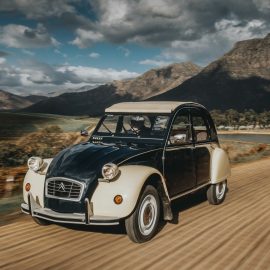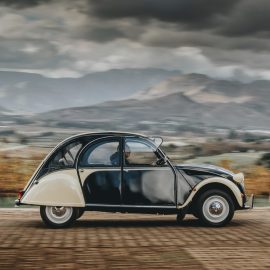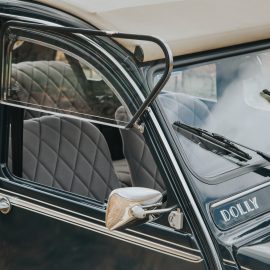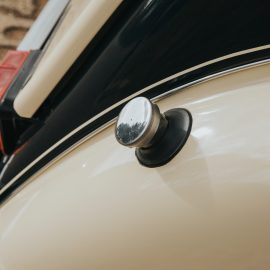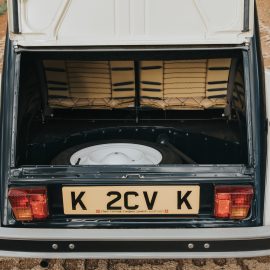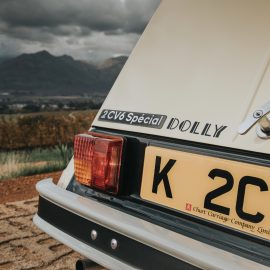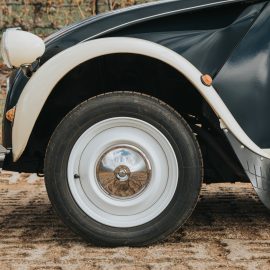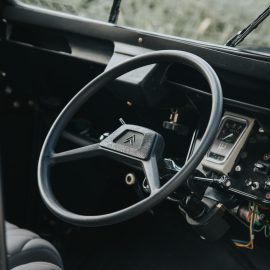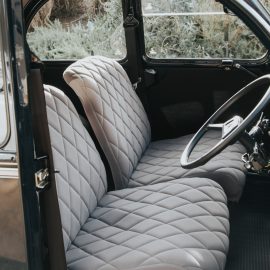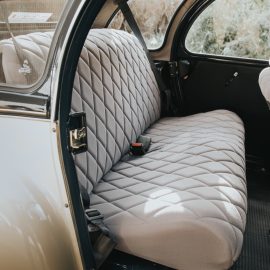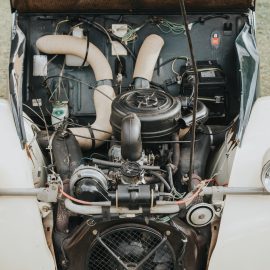
02 Oct Anniversary Celebration: Citroen 2CV
Toutes nos félicitations Deux Chevaux – On October 7, Citroën celebrates the 75th anniversary of the introduction of its iconic and long-lasting model, the 2CV. Mike Monk celebrates a milestone anniversary of Citroën’s oddball 2CV. Hello Dolly…
The Citroen 2CV – Deux Chevaux, or two horses – was France’s equivalent of Germany’s Volkswagen Type 1 – aka Beetle – inasmuch as it offered basic and, critically in the post-war period, affordable transportation for the masses. And by basic I mean basic: by definition, something important or essential serving as a minimum. Adjectively, plain and utilitarian rather than luxurious or fancy also applies.
After Michelin took over the bankrupt Citroën in 1934, the tyre giant immediately carried out a survey to establish what the predominantly rural French market needed. The result was a design brief to create a strongly-built car capable of carrying four people and 50 kg of farm goods over secondary roads to market at 50 km/h and using no more than 3 litres/100km. Oh, and the ability to ‘drive eggs across a freshly ploughed field without breaking them’. No problem then…
In 1936, Pierre-Jules Boulanger, vice-president of Citroën and chief of engineering and design, gave the engineering department instructions to create a strongly-built car capable of meeting the design brief. The Tres (or Toute) Petite Voitre, meaning ‘very small car’, project was to be developed in secrecy at Michelin’s facilities at Clermont-Ferrand and at Citroën in Paris by the team who had created the groundbreaking Traction Avant. Boulanger placed engineer and former race car designer and driver Andre Kefebvre in charge of TPV development, primarily due to his expertise in suspension and chassis design.
By 1939, 47 different prototypes had been built – all with only one headlight, which was a requirement of French law at the time. Aluminium and magnesium parts were used in the construction. The suspension system offered a modicum of self-levelling. Seating was by hammocks hung from the roof by wires. With rudimentary bodywork and powered by a front-mounted, water-cooled, flat-twin engine driving the front wheels (another traction avant), the TPV was deemed ready for production.
A pilot run of 250 cars was produced and on 28 August 1939 the car received approval for the French market. Renamed the Citroën 2CV, a nod to the taxable rating of 2 hp, brochures were printed and preparations made to debut the car at the Paris Mondial de l’Automobile in October 1939. But together with Britain, France declared war on Germany in September, so the launch was aborted.
As the war progressed and Germany came to occupy France, Boulanger went to great lengths to keep the TPV’s details secret, burying some of the prototypes and, with the aid of the French Resistance, managed to smuggle the car’s tooling to places around Europe. Apparently, he feared the car would be put to military use. But in a positive move, as the fighting was coming to an end, he engaged Walter Becchia to design a new powertrain in anticipation of the 2CV being revived once the war had ended.
Becchia produced a 9 hp (6,7 kW) 375cc air-cooled engine and, for surprisingly little extra cost, a 4-speed gearbox rather than matching most ‘rivals’ three. The major benefit of the extra gear was to counter the car’s increased weight due to the new body, designed by Flaminio Bertoni, and chassis having to be made from steel rather than light alloy as used for the TPV. Seats now had tubular frames with rubber band springing.
Once peace was established, the 2CV was introduced to the public at the Paris Salon on 7 October 1948. UK magazine The Autocar described the 2CV as being the work of a designer ‘who has kissed the lash of austerity with almost masochistic ‘fervour’, but the rural French did not care. It was a bridge between the horse and cart and the motor car.
Orders flooded in. Within months, there was a three-year waiting list, which soon increased to five. By the end of 1951, a van version joined the line-up and production totalled 16 288. The German Auto, Motor Und Sport magazine commented that despite its ‘ugliness and primitiveness’, the 2CV was a ‘highly interesting’ car. A cautious but steady stream of cost-conscious minor improvements was made to the car’s specification. Slight improvements to the engine’s output were also carried out. In 1955 a 425cc version was offered. The 375 was dropped in 1959, to be subsequently replaced with a 602cc derivative in 1963. Models fitted with the 602 were generally referred to as a 2CV6.
During the 1960s production caught up with demand, and 1964 was the 2CV’s best-ever production year. The 2CV was used in a number of innovative marketing exercises aimed at young buyers, and even became associated with the famous cartoon character Tintin. ‘More than just a car – a way of life’ was the advertising slogan.
The car was steadily developed through the 1970s, and in 1974 the highest annual production run of saloons was achieved. In 1978 special edition models also began to appear. The following year, 2CVs were fitted with inboard front disc brakes and the line-up consisted of four models, namely Special, Dolly, Club, Charleston, the latter being an improved version of the Club. It was very popular and as a result, the Club was soon dropped.
The Dolly was an upspec Special, and it is one of these that is part of the FMM collection. Made in 1986, the museum’s car is in superb condition. The additional features amount to two-tone paint, a speedo, an interior light, different door handles and better cloth upholstery. Despite its simple construction, in its own quirky way the 2CV6 is certainly a distinctive and attractive shape.
Even though devoid of any real creature comforts, the interior is welcoming; the seat is soft and comfy and all-round visibility is excellent. The flat-twin fires up with a characteristic beat and – oh no, that gear lever that protrudes from the dashboard! Developing the knack of pulling/pushing/twisting this lever is a black art that has defeated many a motorist. The gate is slightly odd – fourth is on the dog-leg but I manage to find first and pull away with ease. Wiggle it a bit into second… yes, found it, and onward into third. Got it!
The 602 delivers 22 kW at 5 750 r/min and 39 N.m of torque at 3 500, and takes time to get the near-600 kg Dolly up to an easy gait. Steering is light and direct and the ride over the brick-paved roads I am using is so s-m-o-o-t-h. Quickly at ease with the car, I try some spirited cornering that reveals the expected exaggerated body lean, but the skinny 15-inch wheels never leave the ground. An open stretch of road beckons and into top gear, which reveals itself as more of an overdrive, capable of taking Dolly to 115 km/h. With the lower side window pushed outwards and upwards and clicked in to placed, this is a cool place to be.
But then back into the twisties and a series of no engagement/wrong engagement attempts of finding the desired gear belies my early dexterity. Mentally shouting Sacré Bleu! did not help either, but after a swig of Perrier, calm was restored and a second run proved far less frustrating. Simply a case of familiarity…
Although production in France ended in 1988, the 2CV continued to be built in Portugal for another two years before it ceased altogether. In all, 3,87 million cars, 1,25 million vans and just under 700 Sahara derivatives were manufactured – far enough to have rightfully created a place of honour in motoring history.




